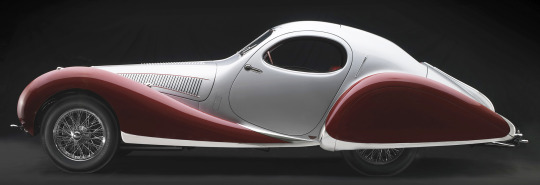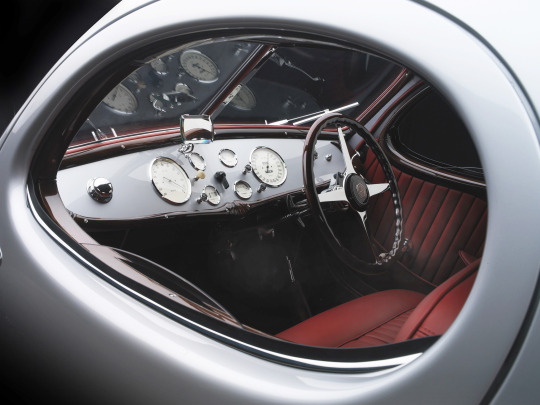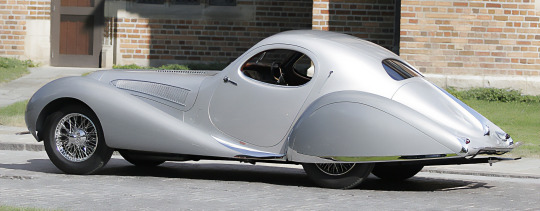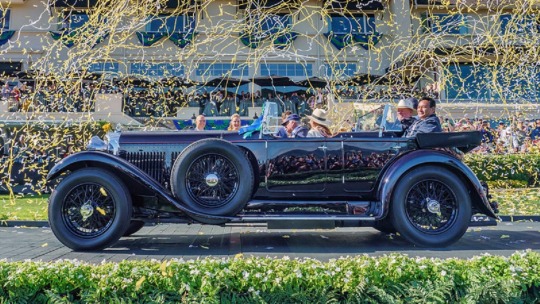#Talbot-Lago Teardrop Coupé
Explore tagged Tumblr posts
Text





Talbot-Lago T150C SS, 1937, by Figoni et Falaschi. In total the Italian/French coachbuilder (Italian-born Giuseppe Figoni partnered with businessman Ovidio Falaschi) built 11 of these hemi-head 6 cylinder "teardrop" coupés but no 2 were the same. One showroom stock T150C SS raced and was placed third overall at the 1938 24 Hours of Le Mans.
#Talbot-Lago#Talbot-Lago T150C SS#Figoni et Falaschi#coachbuilt#Talbot-Lago Teardrop Coupé#Teardrop Coupé#1937#24 hours of le mans#aerodynamic#dead brands#pre war#1930s#straight 6#hemi 6
289 notes
·
View notes
Text

Talbot-Lago T150-C SS Teardrop Coupé 1938. - source Jim Ahlenslager via Art Deco.
107 notes
·
View notes
Text
What’s the Rarest Car in the World—and Why Does It Matter?
If you think of rare cars, what comes to mind? For many, it's those ultra-expensive models that seem almost too exotic to exist. But when it comes to the rarest car in the world, it's not just about price tags or luxury—it’s about uniqueness, history, and scarcity.

One of the rarest cars ever produced is the 1955 Mercedes-Benz 300 SLR Uhlenhaut Coupé. Why is it so rare? There’s only one in existence. The car was designed by Mercedes’ chief engineer, Rudolf Uhlenhaut, and was originally a prototype meant for racing. Despite its incredible design and performance, only two were ever built—one was destroyed in an accident, and the other is still kept in the Mercedes-Benz Museum in Stuttgart, Germany.
1. Why the 300 SLR Uhlenhaut Coupé?
The 300 SLR was a marvel of its time, boasting a top speed of over 180 mph, a 3.0-liter, 8-cylinder engine, and innovative features that were decades ahead of its time. In fact, the car was never meant to be sold to the public, making it even rarer. Its value is immeasurable, not just because of its historical importance but because of how few exist.

2. Other Rare Gems
While the 300 SLR is often hailed as the rarest, other cars follow close behind, such as the 1937 Talbot-Lago T150-C-SS Teardrop Coupe, of which only about 14 were made, or the Ferrari 250 GTO, with only 36 units produced between 1962 and 1964. These cars are not only rare but also highly sought after by collectors for their design, performance, and rich history.
3. The Significance of Rarity
Rarity in cars isn’t just about numbers. It’s about the engineering, the legacy, and sometimes, the story behind the car. A rare car doesn’t just represent automotive history—it’s a symbol of human creativity and precision.
In conclusion, while the Mercedes-Benz 300 SLR Uhlenhaut Coupé holds the title of the rarest car in the world due to its extreme scarcity and historical significance, many other rare vehicles continue to capture the imagination of collectors and car enthusiasts. What rare car would you love to own, or do you have a different opinion on the rarest car in the world?
4 notes
·
View notes
Text

1938 Talbot-Lago T150-C SS Teardrop Coupé
14 notes
·
View notes
Text

1937 Talbot-Lago T150-C SS ‘Goutte d’Eau’ Coupé by Figoni et Falaschi known for their lavish designs. Goutte d'eau is teardrop in French.
143 notes
·
View notes
Photo


1937 Talbot Lago T150SS Figoni & Falaschi 'Teardrop' Coupé
4 notes
·
View notes
Photo

Talbot Lago T23 Teardrop Coupé
1 note
·
View note
Text




Talbot-Lago T150 C Teardrop Coupé, 1938, by Figoni & Falaschi. Designed by Joseph Figoni and Ovidio Falaschi, the car was first revealed at the 1937 Paris Motor Show. An unmodified car came third at the 1938 Le Mans 24 hours. It was powered by a 160hp 4.0 litre straight 6 and was was one of the first cars to be finished in Nitrolac metallic paint
#Talbot-Lago#Talbot-Lago T150 C Teardrop Coupé#Figoni & Falaschi#coachbuilt#aerodynamic#1938#straight 6#metallic paint#1930s style
553 notes
·
View notes
Photo

Talbot-Lago Coupé Type 150 SS 1937 Figoni & Falaschi Teardrop.. - source We love classic cars.
70 notes
·
View notes
Photo

Talbot-Lago T23 Teardrop Coupé – 1938
2 notes
·
View notes
Text
Bentley 8 Litre 1931 leva o troféu ‘Best of Show’ em Peeble Beach
A disputa é ferrenha. Afinal, todos os competidores sempre são extremamente credenciados. Por isso mesmo, é tão honroso ganhar um prêmio no Pebble Beach Concours d’Elegance, um dos eventos de antigomobilismo mais sofisticados do mundo, que neste ano chegou à 69ª edição, sempre realizado em Monterey, na Califórnia, EUA. Se o troféu em questão for o Best of Show, concedido ao veículo mais especial da mostra, então, nem se fala. Pois neste ano, o ganhador dessa comenda foi um Bentley 8 Litre Gurney Nutting Sports Tourer 1931.

O modelo foi eleito entre outros três finalistas: Talbot-Lago T150C-SS Figoni & Falaschi Teardrop Cabriolet 1938, um Mercedes-Benz 540K Erdmann & Rossi Special Cabriolet 1936 e um Aston Martin DB4GT Zagato Coupé 1962. Todos eles são verdadeiras joias da indústria automobilística. Porém, justamente no ano em que a Bentley comemora seu centenário, os jurados optaram pelo 8 Litre Gurney Nutting Sports Tourer 1931.
O proprietário da raridade é Sir Michael Kadoorie, de Hong Kong. Ele admitiu, em um comunicado, que o centenário da marca inglesa pode ter causado algum reflexo no resultado. Porém, destacou que o 8 Litre é o modelo que mais representa a Bentley. “Eu tenho muita sorte de ter um carro tão elegante e bem-construído, que o Pebble Beach Concours julgou ser digno (do prêmio), declarou.”
Você viu? Placa preta: saiba o que é mito e o que é verdade
Desde 1965, um veículo da Bentley não ganhava o troféu Best of Show em Peeble Beach. O modelo 8 Litre é um dos mais raros da marca inglesa: apenas cerca de 100 unidades foram fabricadas entre 1930 e 1932. O nome do bólido faz alusão ao motor de seis cilindros em linha, cuja cilindrada é de impressionantes 8.000 cm³.
Além do Bentley 8 Litre, outras preciosidades também foram premiadas
O troféu Best of Show é o mais importante, mas não é o único concedido em Beeble Beach. O Talbot-Lago T150C-SS Figoni & Falaschi Teardrop Cabriolet 1938, que foi finalista ao prêmio máximo, acabou sendo eleito o veículo cabriolet mais elegante da mostra.
Já um Alfa Romeo 6C 2500 Coupé 1950 Ghia Supergioiello 1950 foi considerado o automóvel fechado mais elegante. Um Rolls-Royce Phantom I Brewster York Roadster 1929 ganhou a honraria de carro aberto mais elegante. Por fim, uma Ferrari 250 GT Zagato Berlinetta Speciale 1956 foi o esportivo mais elegante.
Acompanhe o AutoPapo também no Youtube!
Foto Pebble Beach Concours d’Elegance | Divulgação
O post Bentley 8 Litre 1931 leva o troféu ‘Best of Show’ em Peeble Beach apareceu primeiro em AutoPapo.
https://autopapo.com.br/noticia/bentley-8-litre-1931-best-of-show-peeble-beach/ encontrado originalmente em https://autopapo.com.br
0 notes
Text
Best Cars of the 2018 Pebble Beach Concours d’Elegance
The 1937 Alfa Romeo 8C 2900B Touring Berlinetta that won the Best of Show prize at the 2018 Pebble Beach Concours d’Elegance is certainly an amazing machine, but there’s far more to the Concours than naming a single best car. We polled our editors and contributors for some of their favorites spotted Sunday on the 18th fairway.

Tucker 48s Take Over Pebble
It’s exceedingly rare to see a singular Tucker 48 outside of the walls of a climate-controlled automotive museum, so running into 12 Tuckers lined up like a dealership sales lot was surreal. Even in the company of Marmon Sixteens and Hispano-Suizas, the pack of earth-toned Tuckers was an unbelievably special sight. —Conner Golden

1948 Talbot Lago T26 Grand Sport Figoni Fastback Coupe
This gorgeous Figoni-bodied Talbot Lago features classic teardrop styling, elegant chrome accent trim, and even a clear pop-up sunroof, a rarity for its day. Post-war cars struggle to win Best of Show at Pebble Beach, but the Czech-based owners of this car can take solace in their First in Class win in the Postwar Touring category. —Rory Jurnecka
(Not So) Fastback
I’m with Mr. Jurnecka on this one. Predicting an overall Pebble Beach Concours d’Elegance winner is never as straightforward as it seems, and the Talbot Lago is a case in point. The T26 Grand Sport Figoni Fastback Coupé seemingly has it all: imaginative styling, interesting custom details (including chrome “zippers” above its center headlamp from its original owner, the so-called Zipper King), a heroic rescue following 48 years of storage, and novel styling. Sure, the Best in Show–winning Alfa had understated qualities that could be described as safe, but it goes to show sometimes you never can tell. —Basem Wasef

The Cadillac Mind Melt Is it a Delahaye? A Delage? Or maybe some other dreamy, French Curvy scoop of rolling sculpture? This kinetic object d’art, it turns out, is actually a good ol’ fashioned Caddy—specifically a rather special, 1937 Cadillac Series 90 Hartmann Cabriolet originally commissioned by international playboy Philippe Barraud. Wrapped in fluid sheetmetal that could best be described as Figoni et Falaschi-esque and powered by a narrow-angle V-16, this particular Caddy’s impossible, 22-foot-long proportions made waves. Many wagered that this swoopy cab would win the top Concours prize, but it settled instead for the class win in its American Classic Open category. Shame, as this Cadillac seemed to have it all: a great story, stunning lines, and elegance for miles. —B.W.

1937 Cadillac Series 90 Hartmann Cabriolet I see we’re in agreement on some of these choices, which isn’t always a guarantee when it comes to the Automobile staff and its varied tastes. I think that fact speaks to just how exceptional some of these standout cars are. This Cadillac isn’t straight out of The Great Gatsby, and it was created a dozen years too late for inclusion in the novel, but it certainly channels author F. Scott Fitzgerald’s masterwork. You don’t have to have even a passing interest in cars to take note of this one: a one-of-a-kind coachbuilt Cadillac commissioned by a wealthy Swiss gentleman 80-some years ago—a car many indeed pegged as the favorite to win the Pebble Beach Concours’ top award. No, it didn’t, but it checked a lot of boxes: rarity, an interesting history, immaculate design, and meticulous resurrection. Best of Show recognition or not, no one who laid eyes on it could look away. —Mac Morrison

1970 Ferrari Modulo 512 S Pininfarina Coupe Jim Glickenhaus, founder of Scuderia Cameron Glickenhaus and owner of some very rare cars, brought this 1970 Ferrari Modulo, which he managed to wrest away from Pininfarina’s long-term ownership. This wild 1970 concept car was based on the low-slung chassis and racing powertrain from a Ferrari 512 S endurance prototype sports car. The roof slides backward to allow entry, and a perforated engine cover allows onlookers to see the race-tuned V-12 that lies underneath. —R.J.

Ferrari Modulo… You Know, for Kids Did you steal my notes, Jurnecka? Frankly, Pebble’s Pre-War-a-Palooza can alienate some of the younger showgoers who lack a penchant for brass and wicker. For the (slightly) more youthful set, the 1970 Ferrari 512 S Modulo Pininfarina Coupe owned by James Glickenhaus ticks a whole lot of boxes: pivotal role in the game-changing supercar wedge movement? Check. Just-in-time engine restoration to make it mobile and Pebble Beach eligible? Check. Racing chassis, 5.0-liter V-12 under Perspex, and boggling doorstop silhouette? Triple check. The Modulo may not have won Pebble, but it certainly did win the hearts of more than a few enthusiasts in the crowd. —B.W.

1966 All American Eagle Special
Now owned by well-known restorer, collector, and all-around performance-car guy Bruce Canepa, this All American Racers Indy car might have been overlooked, especially by some young members of the Pebble crowd. And that’s a shame, as it is flat-out gorgeous. Its provenance might not be as impressive as some of AAR founder Dan Gurney’s other racers, as it never won a race. But it is the car the man himself ran at Indianapolis in ’66. This example, chassis No. 201, is the first of six such race cars AAR built that year; unfortunately, it and Gurney were taken out in an opening-lap crash at the Speedway.
Regardless, it was a gem on display at Pebble, a race car from a bygone era when beauty was appreciated almost as much as performance. The good news is, an even younger crowd will soon be exposed to it after it won the Gran Turismo Trophy (the Concours award associated with the famous video game), meaning this sublime competition car will (sooner than later, we hope) appear in the massively popular racing franchise. —M.M.

And the Best Spare Tire Award Goes to … The 1966 Ford GT40 Mark IIB. This final version of the GT40 race car is special, even though its favored status at Le Mans was thwarted by a blown head gasket in ’66, and it failed to finish again the following year after 13 hours of competition. We love its legendary lines and sexy gold livery, but we really dig the magnesium spare wheel tucked perilously close to the drivetrain; gotta love 1960s racing. —B.W.

1966 Ford GT40 Mark IIB Coupe I’m a sucker for GT40s, and as Basem notes above, this gold-sprayed coupe with white striping is one of the most stunning I’ve seen. Seemingly every GT40 of the 1960s has a story, and this car is no different. It was driven in the ’66 24 Hours of Le Mans by Dan Gurney and Jerry Grant and started on the pole, but a radiator issue hosed its chances and it didn’t finish. After being upgraded to IIB-spec, it raced at Le Mans in 1967 but crashed out. There is some controversy around this particular car as its chassis number of 1047 was somehow mixed up with another sister car known as 1031. —M.F.

File Under: Strong Finishes As if an imposing Rolls-Royce doesn’t say enough about the class divide between rich and poor during imperialist India, this 1927 Rolls-Royce Phantom I Windovers limousine goes the extra mile with its stunning polished aluminum finish. The texture of bare metal must have required hundreds of man-hours to perfect and is just as telling of the car’s meticulous ownership history as it is about the marque’s 20th century origins. —B.W.

1958 Continental Mark III Convertible It is next to impossible to truly communicate the scale of this battleship in words and photos, but here goes. Holy hell, is this thing big, long, and massive! From the era when American land yachts roamed the interstates, as the largest unit-construction car ever built, this was one of the biggest of them all. This was the last year the Continental wasn’t badged a Lincoln, as it was its own sub-brand at the time. Powered by a 430-cubic-inch V-8 with around 375 horsepower, it is a whopping 229 inches long, but not exactly super heavy at around 5,000 pounds. Imagine trying to park this leviathan anywhere. That said, we’d love to try, after driving it everywhere, of course. —M.F.

1953 OSCA MT4 Frua Spider OSCA was a special class at the 2018 Pebble Beach Concours d’Elegance, and the largely open-top race cars were an impressive lot. Known officially as Officine Specializzate Costruzione Automobili—Fratelli Maserati S.p.A., OSCA was an Italian manufacturer of racing and sports cars established in 1947 by the Maserati brothers, and it lasted until 1967. This particular car caught my eye, with its stunning blue, white, and red accented livery and white wire wheels. Many aficionados consider the MT4 the most successful race car the Maserati brothers ever produced, as it became a force in the under-1,500cc class during its era. —M.F.

1949 OSCA MT4 Siluro The Concours’ clutter of OSCAs consisted primarily of itty-bitty competition barchettas, and there weren’t any eyesores in the bunch. But I took particular interest in the 1949 OSCA MT4 Siluro. Or more specifically, the Siluro’s floating shift tube that extends from under the dash. It’s a feature entirely driven by engineering, but it’s so much more dramatic than some of the aesthetic extras sprinkled on some of the flamboyant sleds on the show green. —C.G.

1963 Citroën DS19 Chapron
The inimitable Citroën DS is hardly the most highfalutin car to escape France. While not as Spartan as the 2CV, the DS was reasonably egalitarian and became a symbol for accessible design and smart engineering. Citroën made roughly 1.5 million of the things, after all.
Peter Mullin’s 1963 Citroën DS19 Chapron Concorde is a bit different. A star coachworks designer for the likes of Delahaye, Delage, and Talbot-Lago, Henri Chapron penned the near-perfect bodywork for the Concorde, reinterpreting the DS’ funky aeronautical shape into an effortlessly elegant coupe marketed toward a buyer looking for more luxury. Only a handful of these were made, so this was a rare chance to see a Concorde in public. —C.G.

1935 Rolls-Royce Phantom II Continental Gurney Nutting Streamline Coupe There was a special class at the Concours d’Elegance this year, “Motor Cars of the Raj,” featuring a number of incredibly elegant coachbuilt models like this magnificent example of a Rolls-Royce Phantom II Continental, all brought over from India just for the show. (Apparently, all of the cars’ owners had to ship them to Pebble three months prior to the big day—quite a commitment.) This particular car won its class and also the Lucius Beebe Trophy as the best Rolls-Royce of the Concours, and it’s easy to see why, looking resplendent in its green and yellow paint scheme. In fact, this car is so fabulous, it was chosen as the cover car for this year’s official Pebble Beach Concours d’Elegance poster. —M.F.

from Performance Junk Blogger Feed 4 https://ift.tt/2NocChU via IFTTT
0 notes
Text
Best Cars of the 2018 Pebble Beach Concours d’Elegance
The 1937 Alfa Romeo 8C 2900B Touring Berlinetta that won the Best of Show prize at the 2018 Pebble Beach Concours d’Elegance is certainly an amazing machine, but there’s far more to the Concours than naming a single best car. We polled our editors and contributors for some of their favorites spotted Sunday on the 18th fairway.

Tucker 48s Take Over Pebble
It’s exceedingly rare to see a singular Tucker 48 outside of the walls of a climate-controlled automotive museum, so running into 12 Tuckers lined up like a dealership sales lot was surreal. Even in the company of Marmon Sixteens and Hispano-Suizas, the pack of earth-toned Tuckers was an unbelievably special sight. —Conner Golden

1948 Talbot Lago T26 Grand Sport Figoni Fastback Coupe
This gorgeous Figoni-bodied Talbot Lago features classic teardrop styling, elegant chrome accent trim, and even a clear pop-up sunroof, a rarity for its day. Post-war cars struggle to win Best of Show at Pebble Beach, but the Czech-based owners of this car can take solace in their First in Class win in the Postwar Touring category. —Rory Jurnecka
(Not So) Fastback
I’m with Mr. Jurnecka on this one. Predicting an overall Pebble Beach Concours d’Elegance winner is never as straightforward as it seems, and the Talbot Lago is a case in point. The T26 Grand Sport Figoni Fastback Coupé seemingly has it all: imaginative styling, interesting custom details (including chrome “zippers” above its center headlamp from its original owner, the so-called Zipper King), a heroic rescue following 48 years of storage, and novel styling. Sure, the Best in Show–winning Alfa had understated qualities that could be described as safe, but it goes to show sometimes you never can tell. —Basem Wasef

The Cadillac Mind Melt Is it a Delahaye? A Delage? Or maybe some other dreamy, French Curvy scoop of rolling sculpture? This kinetic object d’art, it turns out, is actually a good ol’ fashioned Caddy—specifically a rather special, 1937 Cadillac Series 90 Hartmann Cabriolet originally commissioned by international playboy Philippe Barraud. Wrapped in fluid sheetmetal that could best be described as Figoni et Falaschi-esque and powered by a narrow-angle V-16, this particular Caddy’s impossible, 22-foot-long proportions made waves. Many wagered that this swoopy cab would win the top Concours prize, but it settled instead for the class win in its American Classic Open category. Shame, as this Cadillac seemed to have it all: a great story, stunning lines, and elegance for miles. —B.W.

1937 Cadillac Series 90 Hartmann Cabriolet I see we’re in agreement on some of these choices, which isn’t always a guarantee when it comes to the Automobile staff and its varied tastes. I think that fact speaks to just how exceptional some of these standout cars are. This Cadillac isn’t straight out of The Great Gatsby, and it was created a dozen years too late for inclusion in the novel, but it certainly channels author F. Scott Fitzgerald’s masterwork. You don’t have to have even a passing interest in cars to take note of this one: a one-of-a-kind coachbuilt Cadillac commissioned by a wealthy Swiss gentleman 80-some years ago—a car many indeed pegged as the favorite to win the Pebble Beach Concours’ top award. No, it didn’t, but it checked a lot of boxes: rarity, an interesting history, immaculate design, and meticulous resurrection. Best of Show recognition or not, no one who laid eyes on it could look away. —Mac Morrison

1970 Ferrari Modulo 512 S Pininfarina Coupe Jim Glickenhaus, founder of Scuderia Cameron Glickenhaus and owner of some very rare cars, brought this 1970 Ferrari Modulo, which he managed to wrest away from Pininfarina’s long-term ownership. This wild 1970 concept car was based on the low-slung chassis and racing powertrain from a Ferrari 512 S endurance prototype sports car. The roof slides backward to allow entry, and a perforated engine cover allows onlookers to see the race-tuned V-12 that lies underneath. —R.J.

Ferrari Modulo… You Know, for Kids Did you steal my notes, Jurnecka? Frankly, Pebble’s Pre-War-a-Palooza can alienate some of the younger showgoers who lack a penchant for brass and wicker. For the (slightly) more youthful set, the 1970 Ferrari 512 S Modulo Pininfarina Coupe owned by James Glickenhaus ticks a whole lot of boxes: pivotal role in the game-changing supercar wedge movement? Check. Just-in-time engine restoration to make it mobile and Pebble Beach eligible? Check. Racing chassis, 5.0-liter V-12 under Perspex, and boggling doorstop silhouette? Triple check. The Modulo may not have won Pebble, but it certainly did win the hearts of more than a few enthusiasts in the crowd. —B.W.

1966 All American Eagle Special
Now owned by well-known restorer, collector, and all-around performance-car guy Bruce Canepa, this All American Racers Indy car might have been overlooked, especially by some young members of the Pebble crowd. And that’s a shame, as it is flat-out gorgeous. Its provenance might not be as impressive as some of AAR founder Dan Gurney’s other racers, as it never won a race. But it is the car the man himself ran at Indianapolis in ’66. This example, chassis No. 201, is the first of six such race cars AAR built that year; unfortunately, it and Gurney were taken out in an opening-lap crash at the Speedway.
Regardless, it was a gem on display at Pebble, a race car from a bygone era when beauty was appreciated almost as much as performance. The good news is, an even younger crowd will soon be exposed to it after it won the Gran Turismo Trophy (the Concours award associated with the famous video game), meaning this sublime competition car will (sooner than later, we hope) appear in the massively popular racing franchise. —M.M.

And the Best Spare Tire Award Goes to … The 1966 Ford GT40 Mark IIB. This final version of the GT40 race car is special, even though its favored status at Le Mans was thwarted by a blown head gasket in ’66, and it failed to finish again the following year after 13 hours of competition. We love its legendary lines and sexy gold livery, but we really dig the magnesium spare wheel tucked perilously close to the drivetrain; gotta love 1960s racing. —B.W.

1966 Ford GT40 Mark IIB Coupe I’m a sucker for GT40s, and as Basem notes above, this gold-sprayed coupe with white striping is one of the most stunning I’ve seen. Seemingly every GT40 of the 1960s has a story, and this car is no different. It was driven in the ’66 24 Hours of Le Mans by Dan Gurney and Jerry Grant and started on the pole, but a radiator issue hosed its chances and it didn’t finish. After being upgraded to IIB-spec, it raced at Le Mans in 1967 but crashed out. There is some controversy around this particular car as its chassis number of 1047 was somehow mixed up with another sister car known as 1031. —M.F.

File Under: Strong Finishes As if an imposing Rolls-Royce doesn’t say enough about the class divide between rich and poor during imperialist India, this 1927 Rolls-Royce Phantom I Windovers limousine goes the extra mile with its stunning polished aluminum finish. The texture of bare metal must have required hundreds of man-hours to perfect and is just as telling of the car’s meticulous ownership history as it is about the marque’s 20th century origins. —B.W.

1958 Continental Mark III Convertible It is next to impossible to truly communicate the scale of this battleship in words and photos, but here goes. Holy hell, is this thing big, long, and massive! From the era when American land yachts roamed the interstates, as the largest unit-construction car ever built, this was one of the biggest of them all. This was the last year the Continental wasn’t badged a Lincoln, as it was its own sub-brand at the time. Powered by a 430-cubic-inch V-8 with around 375 horsepower, it is a whopping 229 inches long, but not exactly super heavy at around 5,000 pounds. Imagine trying to park this leviathan anywhere. That said, we’d love to try, after driving it everywhere, of course. —M.F.

1953 OSCA MT4 Frua Spider OSCA was a special class at the 2018 Pebble Beach Concours d’Elegance, and the largely open-top race cars were an impressive lot. Known officially as Officine Specializzate Costruzione Automobili—Fratelli Maserati S.p.A., OSCA was an Italian manufacturer of racing and sports cars established in 1947 by the Maserati brothers, and it lasted until 1967. This particular car caught my eye, with its stunning blue, white, and red accented livery and white wire wheels. Many aficionados consider the MT4 the most successful race car the Maserati brothers ever produced, as it became a force in the under-1,500cc class during its era. —M.F.

1949 OSCA MT4 Siluro The Concours’ clutter of OSCAs consisted primarily of itty-bitty competition barchettas, and there weren’t any eyesores in the bunch. But I took particular interest in the 1949 OSCA MT4 Siluro. Or more specifically, the Siluro’s floating shift tube that extends from under the dash. It’s a feature entirely driven by engineering, but it’s so much more dramatic than some of the aesthetic extras sprinkled on some of the flamboyant sleds on the show green. —C.G.

1963 Citroën DS19 Chapron
The inimitable Citroën DS is hardly the most highfalutin car to escape France. While not as Spartan as the 2CV, the DS was reasonably egalitarian and became a symbol for accessible design and smart engineering. Citroën made roughly 1.5 million of the things, after all.
Peter Mullin’s 1963 Citroën DS19 Chapron Concorde is a bit different. A star coachworks designer for the likes of Delahaye, Delage, and Talbot-Lago, Henri Chapron penned the near-perfect bodywork for the Concorde, reinterpreting the DS’ funky aeronautical shape into an effortlessly elegant coupe marketed toward a buyer looking for more luxury. Only a handful of these were made, so this was a rare chance to see a Concorde in public. —C.G.

1935 Rolls-Royce Phantom II Continental Gurney Nutting Streamline Coupe There was a special class at the Concours d’Elegance this year, “Motor Cars of the Raj,” featuring a number of incredibly elegant coachbuilt models like this magnificent example of a Rolls-Royce Phantom II Continental, all brought over from India just for the show. (Apparently, all of the cars’ owners had to ship them to Pebble three months prior to the big day—quite a commitment.) This particular car won its class and also the Lucius Beebe Trophy as the best Rolls-Royce of the Concours, and it’s easy to see why, looking resplendent in its green and yellow paint scheme. In fact, this car is so fabulous, it was chosen as the cover car for this year’s official Pebble Beach Concours d’Elegance poster. —M.F.

from Performance Junk Blogger 6 https://ift.tt/2NocChU via IFTTT
0 notes
Photo

Talbot-Lago T23 Teardrop Coupé, 1938.
source: https://twitter.com/HistoryInPix
2 notes
·
View notes

